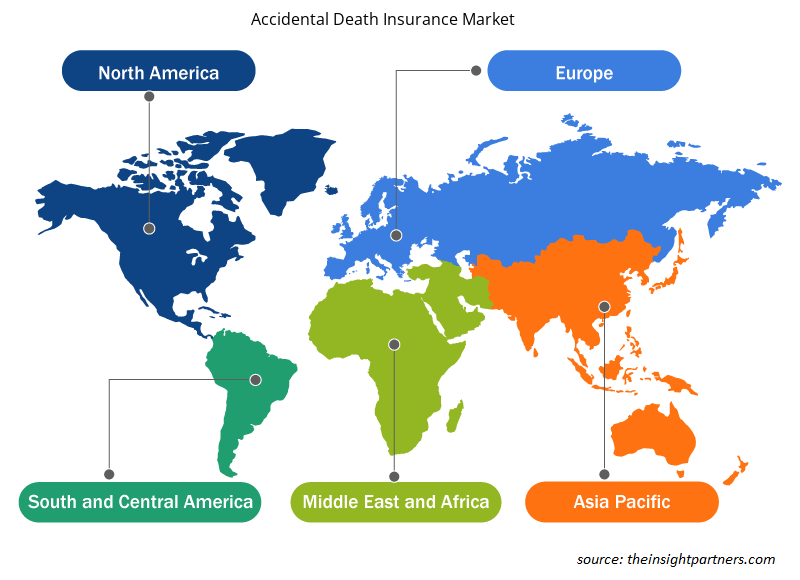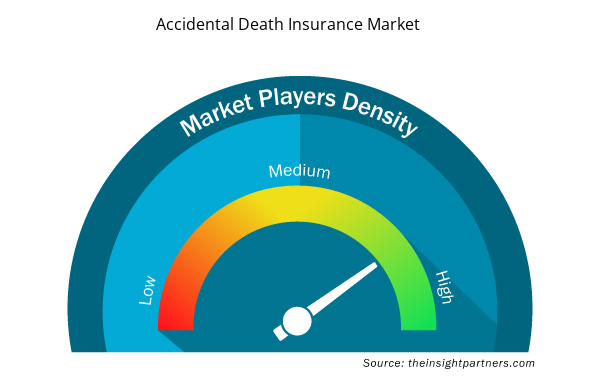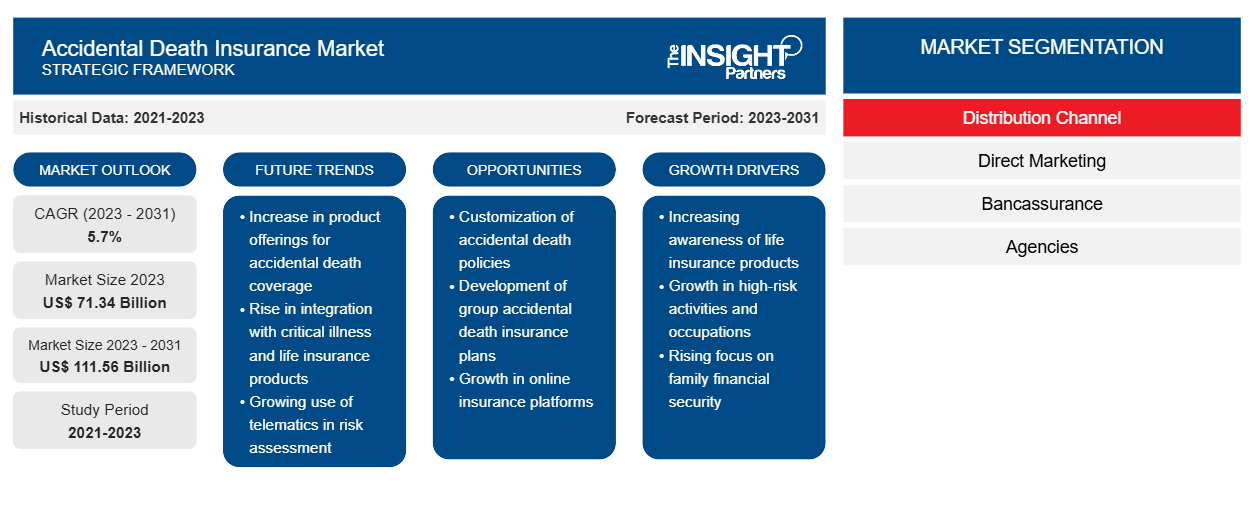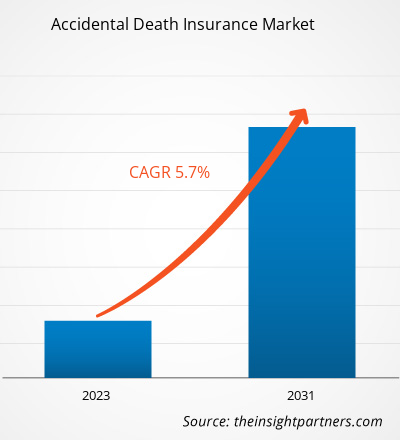死亡保険市場規模は、2023年の713.4億米ドルから2031年には1,115.6億米ドルに成長すると予想されており、2023年から2031年にかけて5.7%のCAGRで拡大すると予想されています。CAGR of 5.7% from 2023 to 2031.
死亡保険市場分析
人々がよりグローバルに移動するようになるにつれて、国境を越えて補償を提供する偶発的死亡保険の需要が増加する傾向にあります。頻繁に旅行する人、海外駐在員、および世界規模のビジネス活動に従事する個人は、場所に関係なくシームレスな保護を提供する保険ソリューションを求めています。保険会社は、世界規模で補償される商品を提供したり、包括的なソリューションを生み出すためにグローバル保険会社と提携したりすることで、この傾向に適応しています。多数の地域でシームレスな補償を提供できる能力は、さまざまな地理的リスクを持つ個人に対する偶発的死亡保険の適用を改善します。
死亡事故保険
業界概要
- 保険業界は、保険テクノロジー事業の増加により近代化の波に見舞われています。傷害死亡保険市場では、保険会社はデジタルプラットフォームを活用して購入手続きを再構築し、顧客体験を向上させ、革新的な商品を提供しています。
- モバイル アプリやオンライン プラットフォームなどのデジタル配信チャネルは、消費者に偶発的な死亡保険を購入、調査、管理するための効率的で便利な方法を提供します。
- 保険会社は、透明性の向上、詐欺の減少、請求処理の迅速化のために、スマート コントラクトやブロックチェーンなどの開発中のテクノロジーも統合しています。保険バリュー チェーンのデジタル化により、アクセス性と手頃さが向上し、不慮の死亡保険がより幅広い層にとって魅力的なものになります。
要件に合わせてレポートをカスタマイズする
このレポートの一部、国レベルの分析、Excelデータパックなど、あらゆるレポートを無料でカスタマイズできます。また、スタートアップや大学向けのお得なオファーや割引もご利用いただけます。
- このレポートの主要な市場動向を入手してください。この無料サンプルには、市場動向から見積もりや予測に至るまでのデータ分析が含まれます。
死亡保険市場の牽引役
技術統合とデータ分析が市場の成長を促進
- デジタル開発の段階では、テクノロジーが保険事業の再構築に重要な役割を果たしており、死亡保険市場も例外ではありません。保険会社は、データ分析や人工知能 (AI) などの革新的なテクノロジーを徐々に活用して、引受手続きの近代化、リスク評価の改善、全体的な業務効率の向上に取り組んでいます。
- データ分析により、保険会社は膨大な量の情報を評価して、より正確なリスク プロファイリングとカスタマイズされた価格設定が可能になります。予測モデリングは、進化する傾向を認識し、引受基準を強化するのに役立ち、リスク管理の改善に貢献します。さらに、テクノロジーによってシームレスな顧客コミュニケーションが可能になり、保険契約者はわかりやすいモバイル アプリやオンライン プラットフォームを通じてデータにアクセスし、請求情報を申請し、保険を管理できるようになります。
- テクノロジーの導入は、顧客体験を向上させるだけでなく、保険会社が変動するリスク環境に効率的に適応できるようにします。テクノロジーが発展し続けるにつれて、予測期間中に、偶発的死亡保険市場における顧客エンゲージメントとリスク評価のさらなる革新が促進されると予想されます。
死亡事故保険
市場レポートのセグメンテーション分析
- 用途に基づいて、偶発死亡保険市場は企業向けと個人向けに分類されます。個人向けセグメントは、2023 年に偶発死亡保険市場で大きなシェアを占めました。
- 死亡保険市場における個人向けと企業向けセグメントの優位性は、各カテゴリの独自の要件と優位性によって左右されます。現在、個人向けセグメントは、その包括的な消費者基盤と個人の金銭的保護の重要性に対する広範な認識により、市場を独占する傾向にあります。消費者は、個人の安全に対する意識の高まりと切望に駆り立てられ、予期せぬ悲劇から家族を守るために、死亡保険を積極的に求めています。
- しかし、企業が従業員に経済的保護を提供することの重要性を認識するにつれて、企業部門の重要性が高まっています。従業員の福利厚生パッケージの一部として不慮の死亡保険を含むことが多い企業保険は、企業部門の成長を支えています。従業員の福利厚生への重点と、一部の業界の規制要件が相まって、企業部門での不慮の死亡保険の受け入れがさらに促進されています。
死亡事故保険
市場地域分析
死亡保険市場レポートの範囲は、主に北米、ヨーロッパ、アジア太平洋、中東およびアフリカ、南米の 5 つの地域に分かれています。北米は急速な成長を遂げており、2022 年には注目すべき死亡保険市場シェアを占めると予想されています。北米が死亡保険市場を支配している理由は数多くありますが、これは地域の財政、人口統計、統治の特徴を反映しています。特に米国は、この優位性において重要な役割を果たしています。この地域の成熟した堅調な保険事業と、個人の間での保険に対する意識の高さが相まって、大きな市場シェアに貢献しています。
米国は多様で人口が多く、生活水準も高いため、経済的保護の必要性が高まっています。個人が自分と家族のための完全な補償を求める中、財務計画とリスク軽減の文化により、不慮の死亡保険を含む保険商品が広く採用されています。さらに、北米、特に米国の統治環境は、保険手続きに有益で安定した枠組みを提供しています。厳格な規制監督により消費者保護が確保され、保険事業への信頼が高まり、消費者と保険会社の両方が市場に積極的に参加するようになります。北米は不慮の死亡保険市場で優位に立っており、技術開発、好調な経済、リスク管理の実践によってさらに推進され、不慮の死亡保険市場の急成長の中心地となっています。
死亡事故保険
死亡保険市場の地域別分析
予測期間を通じて偶発死亡保険市場に影響を与える地域的な傾向と要因は、Insight Partners のアナリストによって徹底的に説明されています。このセクションでは、北米、ヨーロッパ、アジア太平洋、中東、アフリカ、南米、中米にわたる偶発死亡保険市場のセグメントと地理についても説明します。

- 死亡保険市場の地域別データを入手
死亡保険市場レポートの範囲
| レポート属性 | 詳細 |
|---|---|
| 2023年の市場規模 | 713.4億米ドル |
| 2031年までの市場規模 | 1,115.6億米ドル |
| 世界のCAGR(2023年~2031年) | 5.7% |
| 履歴データ | 2021-2023 |
| 予測期間 | 2023-2031 |
| 対象セグメント | 流通チャネル別
|
| 対象地域と国 | 北米
|
| 市場リーダーと主要企業プロフィール |
|
死亡保険市場のプレーヤー密度:ビジネスダイナミクスへの影響を理解する
偶発的死亡保険市場は、消費者の嗜好の変化、技術の進歩、製品の利点に対する認識の高まりなどの要因により、エンドユーザーの需要が高まり、急速に成長しています。需要が高まるにつれて、企業は提供内容を拡大し、消費者のニーズを満たすために革新し、新たなトレンドを活用し、市場の成長をさらに促進しています。
市場プレーヤー密度とは、特定の市場または業界内で活動している企業または会社の分布を指します。これは、特定の市場スペースに、その市場規模または総市場価値に対してどれだけの競合相手 (市場プレーヤー) が存在するかを示します。
死亡保険市場で事業を展開している主要企業は次のとおりです。
- アリアンツSE
- アッシキュラツィオーニ・ジェネラリ SpA
- 中国生命保険株式会社
- メットライフ株式会社
- 中国平安保険会社
免責事項:上記の企業は、特定の順序でランク付けされていません。

- 死亡保険市場のトップキープレーヤーの概要を入手
「事故死亡保険市場分析」調査は、タイプ、アプリケーション、流通チャネル、および地理に基づいて実施されました。タイプ別では、市場は人身傷害請求、交通事故、職場事故、および汎用再ロード可能カードに分類されています。アプリケーション別では、市場はエンタープライズと個人に分類されています。流通チャネル別では、市場はダイレクトマーケティング、バンカシュアランス、代理店、電子商取引、ブローカーに分類されています。地理別では、市場は北米、ヨーロッパ、アジア太平洋、中東およびアフリカ、南米に分類されています。
死亡事故保険
市場ニュースと最近の動向
死亡保険市場では、企業は合併や買収などの無機的および有機的な戦略を採用しています。最近の主要な市場動向をいくつか以下に示します。
- 2024 年 1 月、MSIG 保険は、人生のさまざまな段階で個人を保護するために設計された新しい包括的な個人傷害保険、PA Recovery Plus を導入しました。永久的な障害または事故による死亡が発生した場合、PA RecoveryPlus は支払いを通じて経済的安全を確保します。補償範囲は、毎日の入院収入や医療費の払い戻し、代替治療など、重要な給付にまで及びます。
(出典:MSIG保険、会社ウェブサイト)
死亡事故保険
市場レポートの対象範囲と成果物
市場レポート「偶発死亡保険市場の規模と予測(2021〜2031年)」では、以下の分野を網羅した市場の詳細な分析を提供しています。
- 対象範囲に含まれるすべての主要市場セグメントについて、世界、地域、国レベルでの市場規模と予測。
- 推進要因、制約、主要な機会などの市場の動向。
- 今後の主な動向。
- 詳細なPESTおよびSWOT分析
- 主要な市場動向、主要プレーヤー、規制、最近の市場動向を網羅した世界および地域の市場分析。
- 市場集中、ヒートマップ分析、主要プレーヤー、最近の動向を網羅した業界の状況と競争分析。
- 詳細な企業プロフィール。
- 過去2年間の分析、基準年、CAGRによる予測(7年間)
- PEST分析とSWOT分析
- 市場規模価値/数量 - 世界、地域、国
- 業界と競争環境
- Excel データセット



Report Coverage
Revenue forecast, Company Analysis, Industry landscape, Growth factors, and Trends

Segment Covered
This text is related
to segments covered.

Regional Scope
North America, Europe, Asia Pacific, Middle East & Africa, South & Central America

Country Scope
This text is related
to country scope.
よくある質問
Increasing investments in the accidental insurance market and high adoption in the personal segment are the major factors that propel the global accidental death insurance market.
The global accidental death insurance market was estimated to be US$ 71.34 billion in 2023 and is expected to grow at a CAGR of 5.7% during the forecast period 2023 - 2031.
Digital advancements in the accidental death insurance market to play a significant role in the global accidental death insurance market in the coming years.
The key players holding majority shares in the global accidental death insurance market are Aviva PLC, Allianz SE, MetLife Inc. , AXA SA, Aegon Life Insurance Company Limited
The global accidental death insurance market is expected to reach US$ 111.56 billion by 2031.
Trends and growth analysis reports related to Banking, Financial Services, and Insurance : READ MORE..
- Allianz SE
- Assicurazioni Generali SpA
- China Life Insurance Company Limited
- MetLife Inc.
- Ping An Insurance Company of China Ltd.
- AXA SA
- Sumitomo Life Insurance Company
- Aegon Life Insurance Company Limited
- Dai-ichi Life Insurance Company Limited
- Aviva plc
The Insight Partners performs research in 4 major stages: Data Collection & Secondary Research, Primary Research, Data Analysis and Data Triangulation & Final Review.
- Data Collection and Secondary Research:
As a market research and consulting firm operating from a decade, we have published and advised several client across the globe. First step for any study will start with an assessment of currently available data and insights from existing reports. Further, historical and current market information is collected from Investor Presentations, Annual Reports, SEC Filings, etc., and other information related to company’s performance and market positioning are gathered from Paid Databases (Factiva, Hoovers, and Reuters) and various other publications available in public domain.
Several associations trade associates, technical forums, institutes, societies and organization are accessed to gain technical as well as market related insights through their publications such as research papers, blogs and press releases related to the studies are referred to get cues about the market. Further, white papers, journals, magazines, and other news articles published in last 3 years are scrutinized and analyzed to understand the current market trends.
- Primary Research:
The primarily interview analysis comprise of data obtained from industry participants interview and answers to survey questions gathered by in-house primary team.
For primary research, interviews are conducted with industry experts/CEOs/Marketing Managers/VPs/Subject Matter Experts from both demand and supply side to get a 360-degree view of the market. The primary team conducts several interviews based on the complexity of the markets to understand the various market trends and dynamics which makes research more credible and precise.
A typical research interview fulfils the following functions:
- Provides first-hand information on the market size, market trends, growth trends, competitive landscape, and outlook
- Validates and strengthens in-house secondary research findings
- Develops the analysis team’s expertise and market understanding
Primary research involves email interactions and telephone interviews for each market, category, segment, and sub-segment across geographies. The participants who typically take part in such a process include, but are not limited to:
- Industry participants: VPs, business development managers, market intelligence managers and national sales managers
- Outside experts: Valuation experts, research analysts and key opinion leaders specializing in the electronics and semiconductor industry.
Below is the breakup of our primary respondents by company, designation, and region:

Once we receive the confirmation from primary research sources or primary respondents, we finalize the base year market estimation and forecast the data as per the macroeconomic and microeconomic factors assessed during data collection.
- Data Analysis:
Once data is validated through both secondary as well as primary respondents, we finalize the market estimations by hypothesis formulation and factor analysis at regional and country level.
- Macro-Economic Factor Analysis:
We analyse macroeconomic indicators such the gross domestic product (GDP), increase in the demand for goods and services across industries, technological advancement, regional economic growth, governmental policies, the influence of COVID-19, PEST analysis, and other aspects. This analysis aids in setting benchmarks for various nations/regions and approximating market splits. Additionally, the general trend of the aforementioned components aid in determining the market's development possibilities.
- Country Level Data:
Various factors that are especially aligned to the country are taken into account to determine the market size for a certain area and country, including the presence of vendors, such as headquarters and offices, the country's GDP, demand patterns, and industry growth. To comprehend the market dynamics for the nation, a number of growth variables, inhibitors, application areas, and current market trends are researched. The aforementioned elements aid in determining the country's overall market's growth potential.
- Company Profile:
The “Table of Contents” is formulated by listing and analyzing more than 25 - 30 companies operating in the market ecosystem across geographies. However, we profile only 10 companies as a standard practice in our syndicate reports. These 10 companies comprise leading, emerging, and regional players. Nonetheless, our analysis is not restricted to the 10 listed companies, we also analyze other companies present in the market to develop a holistic view and understand the prevailing trends. The “Company Profiles” section in the report covers key facts, business description, products & services, financial information, SWOT analysis, and key developments. The financial information presented is extracted from the annual reports and official documents of the publicly listed companies. Upon collecting the information for the sections of respective companies, we verify them via various primary sources and then compile the data in respective company profiles. The company level information helps us in deriving the base number as well as in forecasting the market size.
- Developing Base Number:
Aggregation of sales statistics (2020-2022) and macro-economic factor, and other secondary and primary research insights are utilized to arrive at base number and related market shares for 2022. The data gaps are identified in this step and relevant market data is analyzed, collected from paid primary interviews or databases. On finalizing the base year market size, forecasts are developed on the basis of macro-economic, industry and market growth factors and company level analysis.
- Data Triangulation and Final Review:
The market findings and base year market size calculations are validated from supply as well as demand side. Demand side validations are based on macro-economic factor analysis and benchmarks for respective regions and countries. In case of supply side validations, revenues of major companies are estimated (in case not available) based on industry benchmark, approximate number of employees, product portfolio, and primary interviews revenues are gathered. Further revenue from target product/service segment is assessed to avoid overshooting of market statistics. In case of heavy deviations between supply and demand side values, all thes steps are repeated to achieve synchronization.
We follow an iterative model, wherein we share our research findings with Subject Matter Experts (SME’s) and Key Opinion Leaders (KOLs) until consensus view of the market is not formulated – this model negates any drastic deviation in the opinions of experts. Only validated and universally acceptable research findings are quoted in our reports.
We have important check points that we use to validate our research findings – which we call – data triangulation, where we validate the information, we generate from secondary sources with primary interviews and then we re-validate with our internal data bases and Subject matter experts. This comprehensive model enables us to deliver high quality, reliable data in shortest possible time.


 このレポートの無料サンプルを入手する
このレポートの無料サンプルを入手する